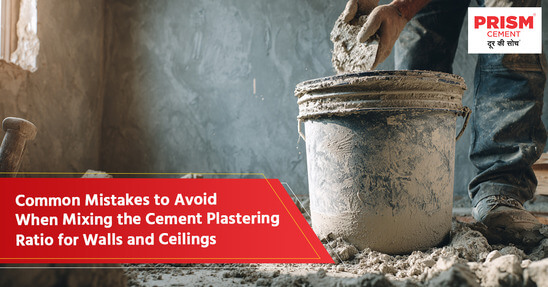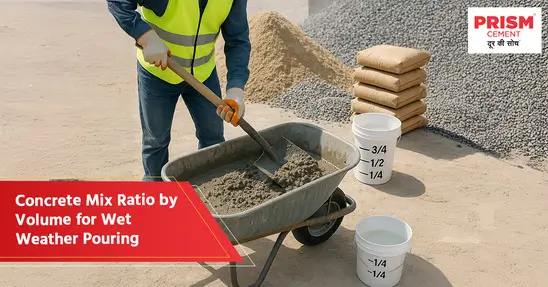A smooth and long-lasting finish in wall plastering is dependent on the right cement plastering ratio. An improper mix may result in structural defects as well as aesthetic imperfections. This blog delves into general errors to avoid when mixing cement plaster for walls and ceilings.
Understanding the Cement Plastering Ratio
The cement plastering ratio is the ratio of cement and sand used in the plaster. The most common ratios are 1:4 or 1:6, with 1 part cement and 4 or 6 parts sand. The actual ratio will depend on the application and environmental conditions. The ratio is important to ensure that the strength and workability are as desired.
Common Mistakes in Mixing Cement Plastering Ratio
- Incorrect Measurement: One of the most frequent errors is improper measurement of cement and sand. Inconsistent ratios can result in a plaster that is either too thin or too thick.
- Incorrect Mixing: Inadequate mixing can lead to an inconsistent distribution of cement and sand, resulting in weak spots and potential cracks.
- Use of Contaminated Materials: Impurities in sand or cement can affect plaster quality. Ensure that the sand is clean and free of organic matter.
- Excessive or Low Water Content: Using too much or too little water can affect the workability and strength of the plaster. Excessive water will weaken the mix, while insufficient water will hinder its application.
- Overlooking Environmental Conditions: Temperature and humidity affect both the setting time and the strength of the plaster. The water content and curing process should be adjusted accordingly.
- Employing Expired Cement: Cement has an expiration date; using expired cement can result in a weaker plaster mix. Always check the date of manufacture before use.
- Not using the correct tools: The right tools for mixing and application are critical. Hand mixing often leads to inconsistencies.
- Not knowing the product: Although cement plaster is common, other products like Plaster of Paris require different mixing and application techniques.
Importance of Curing Process:
Curing is a critical phase that involves keeping the plaster moist for several days to allow complete hydration. Neglecting proper curing may lead to cracking and diminished strength.
Best Practices for Obtaining a Flawless Cement Plastering Mix
- Precise measurement: Use proper measuring instruments to maintain consistent proportions of cement and sand.
- Good mixing: Ensure thorough mixing by first blending the dry materials and then gradually adding water while mixing continuously.
- Use of clean materials: Use high-quality, fresh cement and clean sand.
- Correct water content: Slowly add water until the desired consistency is obtained.
- Take environmental conditions into account: Adjust the mix and curing process based on the ambient temperature and humidity.
- Proper curing: Maintain moisture by spraying water or covering the plaster with a damp cloth for at least seven days.
- Use the correct tools: Utilize proper tools to ensure consistency and ease of application.
- Understand the application: Ensure you understand the specific properties and requirements of cement plaster before beginning your work.
- Use correct materials: Use appropriate, high-quality materials for the best results.
- Take into account the product type: When working with a cement-based grout, follow the manufacturer's guidelines.
- Know the cement wall: Assess the condition of the existing cement wall before applying plaster.
- Buy the right product: Ensure that you purchase the appropriate wall plaster cement for your project.
Conclusion
Avoiding common errors in the cement plastering ratio is crucial for achieving a strong, long-lasting finish. By following the best practices and paying close attention to detail, you can ensure that your walls and ceilings are flawlessly plastered.
FAQs
Q1. What is the best cement plastering ratio for walls and ceilings?
Answer: The ideal ratio is generally 1:4 or 1:6, but this may differ depending on particular project demands and environmental conditions.
Q2. How does an incorrect plastering ratio impact wall strength and durability?
Answer: An incorrect ratio will create weak points, cracks and lower durability, weakening the structural integrity of walls and ceilings.
Q3. What are the most common errors individuals make when mixing cement plaster?
Answer: Some of the common errors are inaccurate measurement, improper mixing, contaminated materials and incorrect water content.
Q4. How can I achieve a smooth and crack-free plaster finish?
Answer: Ensure a smooth and crack-free finish by using the correct mixing ratio, thorough mixing, appropriate water content and proper curing.
Q5. What is the best way to test if my cement plaster mix is properly prepared?
Answer: The best way is to check the consistency and workability of the mix. A properly prepared mix should be smooth, cohesive, and easy to apply.




